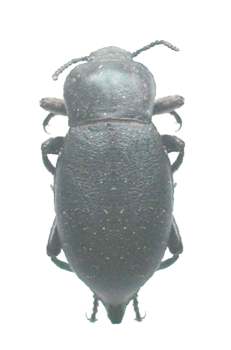Pests
Blaps halophila Fisch. - Steppe Darkling Beetle.
Systematic position.
Class Insecta, order Coleoptera, family Tenebrionidae, genus Blaps.Biological group.
Polyphagous soil-inhabiting pest.Morphology and biology.
Body 17-23 mm in length, black, dull. Pronotum poorly transversal with thin lateral border. Elytra slightly wider than pronotum, narrowed apicad. Caudal process on apex of elytra is 1-1.5 mm long in male, 0.5-1 mm in female. Larva is yellow, up to 35 mm long, with dark rings on each segment. Last abdominal segment has an upwardly curved spike; each side of the spike bears 8-14 aciculae. Larvae of darkling beetles ("false wireworms") are very similar to larvae of click beetles ("wireworms"), but the forelegs of the former are much longer than those of the latter. Beetles are incapable of flying. The pest overwinters during stages of adult and larvae of various instars. Development of eggs lasts 10-12 days, of larva up to 15 months, of pupa about 20 days. Adult beetles live for several years. Female lays up to 300 eggs during a summer; however, young females do not reproduce the first summer.Distribution.
Steppes, south of forest-steppes and northern part of semi-deserts of the European part of the former USSR; the Caucasus, Western Siberia, north and central Kazakhstan. Southeastern and southern Europe. Records citing distribution in Tajikistan, Uzbekistan, and Turkmenia appear erroneous.Ecology.
Beetles overwinter in soil and plant debris. Forest strips, perennial grasses, ravine slopes, weedy sides of roads and fields serve as the main places of hibernation. Beetles appear in the first warm days of early spring when average air temperature reaches about +6°C. Beetles are active in the morning and evening; during the daytime they hide in shelters, e.g. under plant remains. The beetles generally feed on withering plants, e.g. plants cut during mechanical cultivation. Disturbed adult raises its back-end and excretes a stinky liquid. Adults display their sexual activity at temperatures above 12°C. Females lay eggs in crumbly soil to a depth of up to 10 cm, preferring lands with sparse vegetation and plenty of sunshine. The period of egg-laying is highly extended. It is a xerophilous insect, unable to live in moist soils; eggs and larvae perish en mass under conditions of excessive moisture; adults avoid places that are too moist. Larvae feed on seeds and underground parts of plants. Weather conditions of autumn and spring (especially spring thaws combined with frosts), agriculture techniques, and irrigation are the most important factors influencing population of the Steppe Darkling Beetle.Economic significance.
Larvae primarily cause harm to sown seeds in autumn or in spring; germinated seeds are damaged considerably less. Underground parts of stem or rootlets are also damaged. The main cultures preferred by this pest are maize, sugar beet, watermelons, sunflower, castor bean, soybean, and other tilled crops. Adults cause significant harm; sometimes they eat young shoots and damage potato tubers. Control measures include seed treatment, poison baits, stubbing with subsequent autumn plowing, careful treatment of inter-row spaces, treatment of plow-land, and growing of maize and other susceptible crops after winter and spring cereals.Related references:
Alekhin, B.A. 1971. Darkling beetles (Coleoptera, Tenebrionidae) harming to sugar beet in the southeast of the European part of the USSR. Entomol. Review 50 (2): 292-308. (In Russian)Kalyuzhnaya, 1982. Review of darkling beetles (Coleoptera, Tenebrionidae) of north-western Caspian Region. Entomol. Review 61 (1): 67-80. (In Russian)
Knorr, I.B. 1970. Darkling beetles (Coleoptera, Tenebrionidae) of Kulunda steppe. Zool. zhurn. 49 (3): 376-383. (In Russian)
Medvedev, G.S. 1984. Blaps halophila Fischer von Waldheim, 1822. Coleoptera, Tenebrionidae. In: Gorodkov, K.B., ed. Natural habitats of insects of the European part of the USSR. Atlas. Maps 179-221. Leningrad: Nauka. Map 181. P. 23. (In Russian)
Kryzhanovskii O.L., ed. 1974. Insects and mites as pests of agricultural crops. V. 2. Coleoptera. Leningrad: Nauka, 335 p. (In Russian)
Shchegolev, V.N., Znamenskii, A.V. & Bei-Bienko, G.Ya. 1934. Insects harming to field crops. Leningrad & Moscow: OGIZ & Sel'khozgiz, 464 p. (In Russian)


